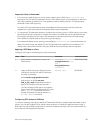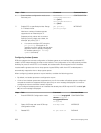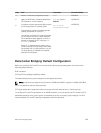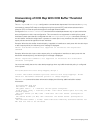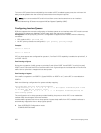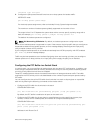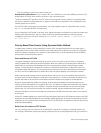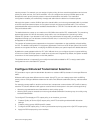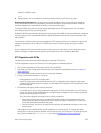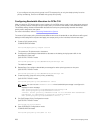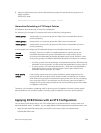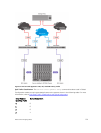used to process. For example, you can assign a higher priority for time-sensitive applications and a lower
priority for other services, such as file transfers. You can configure the amount of buffer space to be
allocated for each priority and the pause or resume thresholds for the buffer. This method of
configuration enables you to effectively manage and administer the behavior of lossless queues.
Although the system contains 9 MB of space for shared buffers, a minimum guaranteed buffer is provided
to all the internal and external ports in the system for both unicast and multicast traffic. This minimum
guaranteed buffer reduces the total available shared buffer to 7,787 KB. This shared buffer can be used for
lossy and lossless traffic.
The default behavior causes up to a maximum of 6.6 MB to be used for PFC-related traffic. The remaining
approximate space of 1 MB can be used by lossy traffic. You can allocate all the remaining 1 MB to
lossless PFC queues. If you allocate in such a way, the performance of lossy traffic is reduced and
degraded. Although you can allocate a maximum buffer size, it is used only if a PFC priority is configured
and applied on the interface.
The number of lossless queues supported on the system is dependent on the availability of total buffers
for PFC. The default configuration in the system guarantees a minimum of 52 KB per queue if all the 128
queues are congested. However, modifying the buffer allocation per queue impacts this default behavior.
By default the total available buffer for PFC is 6.6 MB and when you configure dynamic ingress buffering,
a minimum of least 52 KB per queue is used when all ports are congested. By default, the system enables
a maximum of two lossless queues on the MXL platform.
This default behavior is impacted if you modify the total buffer available for PFC or assign static buffer
configurations to the individual PFC queues.
Configure Enhanced Transmission Selection
ETS provides a way to optimize bandwidth allocation to outbound 802.1p classes of converged Ethernet
traffic.
Different traffic types have different service needs. Using ETS, you can create groups within an 802.1p
priority class to configure different treatment for traffic with different bandwidth, latency, and best-effort
needs.
For example, storage traffic is sensitive to frame loss; interprocess communication (IPC) traffic is latency-
sensitive. ETS allows different traffic types to coexist without interruption in the same converged link by:
• Allocating a guaranteed share of bandwidth to each priority group.
• Allowing each group to exceed its minimum guaranteed bandwidth if another group is not fully using
its allotted bandwidth.
To configure ETS and apply an ETS output policy to an interface, you must:
1. Create a Quality of Service (QoS) output policy with ETS scheduling and bandwidth allocation
settings.
2. Create a priority group of 802.1p traffic classes.
3. Configure a DCB output policy in which you associate a priority group with a QoS ETS output policy.
4. Apply the DCB output policy to an interface.
Data Center Bridging (DCB)
265



